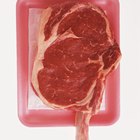
Sour cream is one of life's indulgences. In addition to being a must-have ingredient in salad dressings and dips, sour cream also is a luscious topping for baked potatoes and many Mexican dishes. But like any food product, sour cream has a lifespan, and it’s vital to know when it has gone bad and should be discarded.
Sour Cream Know-How
Step 1
Educate yourself about the differences between “sell by,” “best if used by” and “use by” dates that are imprinted on sour cream tubs. The “sell by” date informs the store how long it should display the sour cream for sale, according to the U.S. Department of Agriculture. Consumers should purchase sour cream before the “sell by” date. “Best if used by” is a quality measure; it tells you when the sour cream will be of the best quality and taste its best. The “use by” date is the last date that the sour cream should be consumed. Both the USDA and the Food and Drug Administration recommend that consumers follow the “use by” date on sour cream.
Step 2
Interpret the “best if used by” date with caution. In general, if the sour cream is unopened, it will be safe in the refrigerator for two weeks after the “best if used by” date. Once the sour cream has been opened, it can be safe for one or two weeks after the date has passed. Note the operative words: “can be safe.” If a tub of sour cream has been left on a counter at room temperature for several hours, bacteria can fester and it will not be safe to eat, no matter what the “best if used by” date.
Step 3
Heed a warning from Weill Cornell Medical College: There is "no absolute expiration date" that guarantees sour cream is safe prior to a "best if used by" date -- or that bacteria is festering immediately after that date. This is why the college calls upon consumers to rely on their common sense and senses and to follow safe food storage advice.
Combine Your Common Sense and Senses
Step 1
Judge the sour cream by its appearance. Look for an unusual amount of whey floating on the surface of the sour cream. Some whey is normal; an abundance is not. Inspect the sour cream for discoloration; moldy green or black areas as well as the bacterial colors of yellow, blue and pink are signs of spoilage. Discard such sour cream tubs immediately. Don’t confuse discoloration with separation, which is normal for sour cream. If your sour cream has separated, stir it with a spoon to return it to its normal consistency.
Step 2
Smell the sour cream. An unfamiliar odor, beyond the normal “sour” aroma, is a sign of spoilage. Throw off-smelling sour cream away.
Step 3
Taste just a little of the sour cream. A strange or bitter taste is a sign that the sour cream is bad and should not be fully consumed.
Step 4
Trust your instincts and err on the side of caution. Or, as Georgia Giannopoulos, registered dietitian at Weill Cornell Medical Center says, “When in doubt, throw it out!”
Related Articles
How Long Can Raw Ground Beef Be ...

Can You Drink Milk That Expires the ...

Does Blue Cheese Spoil?

How to Tell When Tortellini Is Bad

How Can You Tell If Frozen Shrimps Are ...

Can You Cook Pork Two Days After ...
Does Sour Cream Go Bad if Unopened?

What Are the Dangers of Out of Date ...
Can I Eat My Cheddar Cheese Past the ...
How Long Are Canned Meat & Vegetables ...

How Can I Tell If Ricotta Cheese Has ...

How to Tell if Mozzarella Is Bad

Can You Eat Expired Mayonnaise?

How to Know if Beef Cubes Are Bad

Can You Still Cook Eggs If They Are a ...

How Long Can a Bottle of Vodka Last ...

Does Whipped Cream Go Bad?

How to Use Buttermilk That Has Passed ...

Can You Cook Meat Gone Bad?

How Can I Tell If Lunch Meat Has Gone ...
References
- U.S. Department of Agriculture: Food Product Dating
- Food and Drug Administration: Safe Eats: Dairy and Eggs
- Weill Cornell Medical College: Food and Fitness Advisor: When Good Food Goes Bad; How to Tell if it’s Safe to Eat
- Shelf Life Advice: Are There Ways to Tell if Sour Cream is Spoiled?
- FoodSafety.gov: U.S. Department of Health and Human Services: Refrigerated Food and Power Outages: When to Save and When to Throw Out
Resources
Tips
- Store sour cream in a closed container in your refrigerator, which should be set at a temperature of between 38 and 40 degrees Fahrenheit. If the sour cream has been sitting at a temperature above 40 degrees for two hours or more – such as during a long power outage – the sour cream should be tossed out.
- Call the sour cream manufacturer or check its Web site for guidance about its “sell-by” dates. Manufacturer guidelines differ.
- Stack multiple tubs of sour cream in your refrigerator by their “sell by” or “use by” dates so that they are clearly visible. Doing so will guide you to the tubs you should use first and thereby reduce waste.
Writer Bio
Mary Wroblewski earned a master'sdegree with high honors in communications and has worked as areporter and editor in two Chicago newsrooms. She launched her ownsmall business, which specialized in assisting small business ownerswith “all things marketing” – from drafting a marketing planand writing website copy to crafting media plans and developing emailcampaigns. Mary writes extensively about small business issues, andespecially “all things marketing.”
Photo Credits
Jupiterimages/Comstock/Getty Images